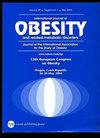Is a higher body mass index associated with longer duration of survival with disability in frail than in non-frail older adults?
IF 4.2
2区 医学
Q1 ENDOCRINOLOGY & METABOLISM
引用次数: 0
Abstract
This study investigated the hitherto unclear association of body mass index (BMI) with age at overall, disability, and disability-free survival in older adults with and without frailty. This prospective cohort study enroled 10232 Japanese adults aged ≥65 years, who underwent follow-up for adverse events, from the Kyoto-Kameoka Study conducted from 2011–2016. BMI, calculated based on self-reported height and body weight, was classified into five categories: <18.5, 18.5–21.4, 21.5–24.9, 25.0–27.4, and ≥27.5 kg/m2. Frailty was assessed using the validated Kihon Checklist. The relationships between BMI and disability and mortality were analysed using multivariate Cox proportional hazards models and Laplace regression. During the 5.3-year median follow-up period (45472 person-years), 2348 (22.9%) incidences of disabilities occurred. After adjusting for confounders, including medical history and lifestyle, individuals in the lowest and highest BMI categories had a higher hazard ratio (HR) of disability [<18.5 kg/m2: HR: 1.31, confidence interval (CI): 1.16–1.49; ≥27.5 kg/m2: HR: 1.27, 95% CI: 1.08–1.49, p for non-linearity <0.001] compared with that of those with BMI = 21.5–24.9 kg/m2. In the 50th percentile differences in age at overall and disability-free survival, participants with BMI < 18.5 kg/m2 were more likely to die before disability incidence [survival with disability (overall survival – disability-free survival): −10.2 months]; those with BMI ≥ 27.5 kg/m2 had longer survival with disability (12.5 months). These relationships were more marked in the frailty-stratified model, where in the BMI ≥ 27.5 kg/m2 group, individuals with frailty survived longer with disability (27.2 months) than did individuals without frailty (6.2 months). Higher BMI is associated with a longer duration of survival with disability among older adults, especially in those with frailty. Therefore, reversing frailty should be prioritised because individuals with frailty have a shorter probability of disability-free survival than do individuals without frailty, regardless of BMI.

身体质量指数越高,体弱老年人的残疾存活时间是否比非体弱老年人更长?
背景/目的:本研究探讨了迄今尚不明确的体重指数(BMI)与有或无体弱症状的老年人的总生存年龄、残疾和无残疾生存率之间的关系:这项前瞻性队列研究从 2011-2016 年开展的 Kyoto-Kameoka 研究中招募了 10232 名年龄≥65 岁的日本成年人,对他们进行了不良事件随访。根据自我报告的身高和体重计算出的体重指数被分为五类:2.使用有效的 Kihon 检查表评估虚弱程度。采用多变量 Cox 比例危险模型和拉普拉斯回归分析了 BMI 与残疾和死亡率之间的关系:在 5.3 年的中位随访期(45472 人年)内,共发生了 2348 例(22.9%)残疾。在对包括病史和生活方式在内的混杂因素进行调整后,体重指数最低和最高类别的个体的残疾危险比(HR)较高[2:HR:1.31,置信区间(CI):1.16-1.49;≥27.5 kg/m2:HR:1.27,95% CI:1.08-1.49,P 为非线性2。在总生存期和无残疾生存期年龄的第 50 百分位数差异中,BMI 为 2 的参与者更有可能在残疾发生前死亡[残疾生存期(总生存期 - 无残疾生存期):-10.2个月];体重指数≥27.5 kg/m2的参与者残疾存活期更长(12.5个月)。这些关系在体弱分层模型中更为明显,在BMI≥27.5 kg/m2组中,体弱者的残疾存活期(27.2个月)长于非体弱者(6.2个月):结论:体重指数越高,老年人残疾存活时间越长,尤其是体弱者。因此,应优先考虑扭转虚弱状况,因为无论体重指数如何,与无虚弱状况的人相比,有虚弱状况的人无残疾存活的概率更短。
本文章由计算机程序翻译,如有差异,请以英文原文为准。
求助全文
约1分钟内获得全文
求助全文
来源期刊

International Journal of Obesity
医学-内分泌学与代谢
CiteScore
10.00
自引率
2.00%
发文量
221
审稿时长
3 months
期刊介绍:
The International Journal of Obesity is a multi-disciplinary forum for research describing basic, clinical and applied studies in biochemistry, physiology, genetics and nutrition, molecular, metabolic, psychological and epidemiological aspects of obesity and related disorders.
We publish a range of content types including original research articles, technical reports, reviews, correspondence and brief communications that elaborate on significant advances in the field and cover topical issues.
 求助内容:
求助内容: 应助结果提醒方式:
应助结果提醒方式:


